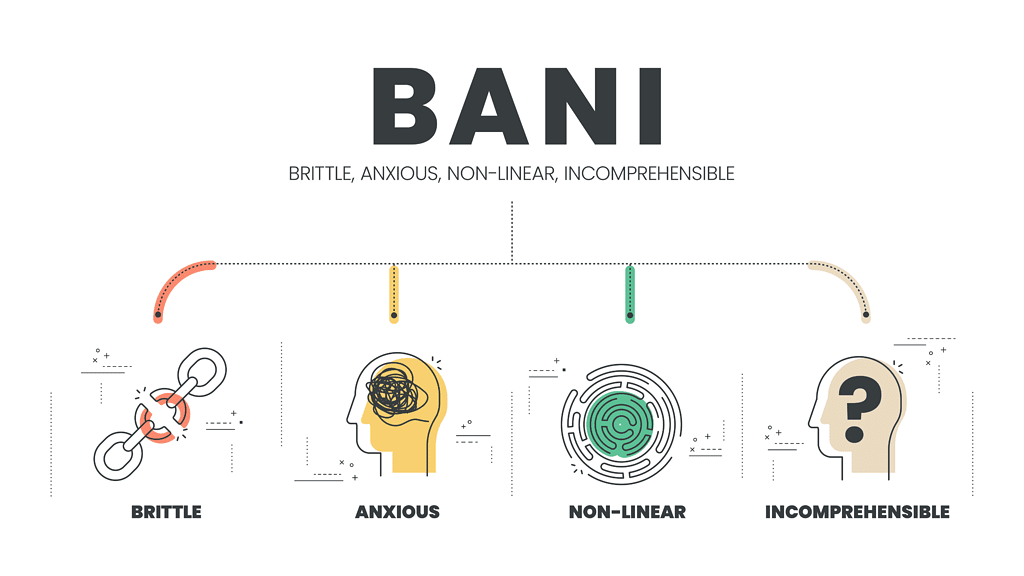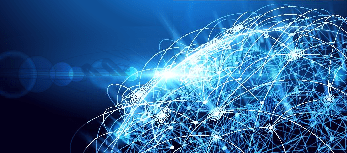

For a long time, VUCA was the leading buzzword in management theory. This concept has undergone adaptation and expansion. BANI is the new VUCA and RAAT is the solution.
In recent years, the topic of VUCA has been a recurring theme in management theory. The acronym stands for volatile, uncertain, complex and ambiguous. It describes the challenges and the world in which we move, and is intended to help find solutions for how we move in this world.
The concept originated in the 1980s, some 40 years ago. But our society and the world have changed a lot since then. And thus a new model is needed to describe today's situation: BANI.
BANI stands for a brittle, anxious, non-linear and incomprehensible world.
Why do we need a new model?
Our brain loves patterns and structures. They help us to understand the world better. With such a model, we can bring order to the existing chaos. VUCA is outdated and author and futurist Jamais Cascio suggests in his article "Facing the Age of Chaos" a new model. Namely BANI.
VUCA emerged during the Cold War and the collapse of the USSR and later gained importance with the increasing digitization. The Cold War is over, and digitization is no longer #new territory. There are new challenges ahead that go beyond VUCA. BANI offers an extension of the thinking here.
VUCA is still a useful and helpful model. But BANI goes further. While VUCA describes the state of the world, BANI also explains the consequences and offers approaches to deal with the challenges that arise.
BANI consists of 4 parts:
The model helps us to understand, classify and react to the situation we are currently experiencing and will experience in the future.

Brittle is the further development of Volatile. Rapid change becomes a problem where a system is not resilient and flexible. A system that is not flexible becomes brittle under stress and does not hold up. A brittle system may still look stable from the outside, but is already porous on the inside and can collapse unexpectedly.

It usually takes a critical point at which the load becomes too great, and the entire system collapses. This is not predictable, but can have great effects.
One example here could be the lack of employee training. If key employees leave the company and these gaps cannot be filled due to a lack of skilled workers, the system becomes porous. The additional burden on the remaining employees increases and at some point there is a major bloodletting and a negative spiral.
Other examples include the collapse of supply chains, following the Suez Canal traffic jam or the lock-downs in China.
Thus, fragility does not only exist in one's own system, but must be considered globally.
Fear is the consequence of uncertainty. We have learned that nothing is certain anymore and that everything can change. This unpredictability makes us afraid. Fear can paralyze us, makes us avoid risk and ultimately leads to passivity. Out of fear of making a wrong decision, none is made at all.
Humans are designed to consume negative news because it protects them from danger. But innovation and progress require the courage to take risks.

Non-linearity describes that our world is not only complex and interconnected, but that cause and effect no longer have a causal relationship.

From A follows B, which leads to C. However, the cause of A can contain a multitude of components and leads not only to B, but to x further effects. This also makes it so difficult to take adequate measures, since the effects are not in any predictable proportion.
A customer once pointed out the connection between prices for plastic and the airline industry. Plastic prices are going up because there was less flying during Corona. Why is that? Aircraft need kerosene. Kerosene production produces a number of by-products, which in turn are feedstocks for plastic production. Since refineries had to cut back on capacity because their warehouses were full, fewer by-products were also produced. Here, networking is already making itself felt. Cause and effect can still be traced. In the case of climate change, cause and effect are not so close in time and are even more difficult to grasp.
As a consequence of the non-linear, complex world, incomprehensibility follows. The system in which we move is not only ambiguous, as in VUCA. But we are simply not able to understand it. The developer of the BANI concept cites a software code as an example. There is a line in some code that would be logically superfluous and serves no explicit function. But without this line, the program crashes. And there is no conclusive explanation for it.

Being able to understand helps to orient oneself. When a company is going through a change process, it is important to explain the background and the goal to the employees. If the employees understand, they can follow more easily.
What we don't understand overwhelms us. Even more information does not help us. So we want simple explanations of complex products. In the future, this will be a focus for product management of goods that require explanation.
We hold: The world we live in is fragile, fearful, non-linear and incomprehensible. How can we nevertheless live in this world and overcome the challenges? Jamais Cascio proposes the concept of RAAT as a response to BANI. RAAT stands for Resilience, Attentiveness, Adaptation and Transparency.
Resilience against Brittleness
Resilience describes the ability to survive difficult life situations without sustained impairment. A resilient system is better able to withstand external stress and overcome crises. This is crucial both at the personal level and in the overall organization.
Mindfulness means being in the here and now - not only physically, but also mentally. In the BANI world, this means stopping the negative carousel of thoughts. Mindfulness can help to take away the fear of making wrong decisions, which leads to the ability to act.
Humans are incredibly flexible and can adapt again and again. We need this adaptability to be able to operate in a non-linear world. For those who can deal flexibly with the results, it is less important what they came from. We cannot change the past, but we can take the future into our own hands.
What we do not understand does not seem meaningful to us. But meaningfulness is an important factor in mental health and satisfaction. Transparency creates better understanding. The questions "What?", "Why?" and "What for?" help to bring more clarity into the system.
The following graphic shows again a summary of how we can describe from the "old" VUCA world the current and future BANI world and which tools (RAAT) help us to deal with it.

All organizations today face the challenge of adapting to these circumstances. With the right employees, it is possible to gain an edge over the competition and continue to be successful in the future.
We connect you with the right people and take you further in your development. Contact us and let us advise you.
Batterman Consulting Basel AG
Executive Search,
Byfangweg 1a, CH-4051 Basel
T +41 58 680 55 55
basel@batterman.ch